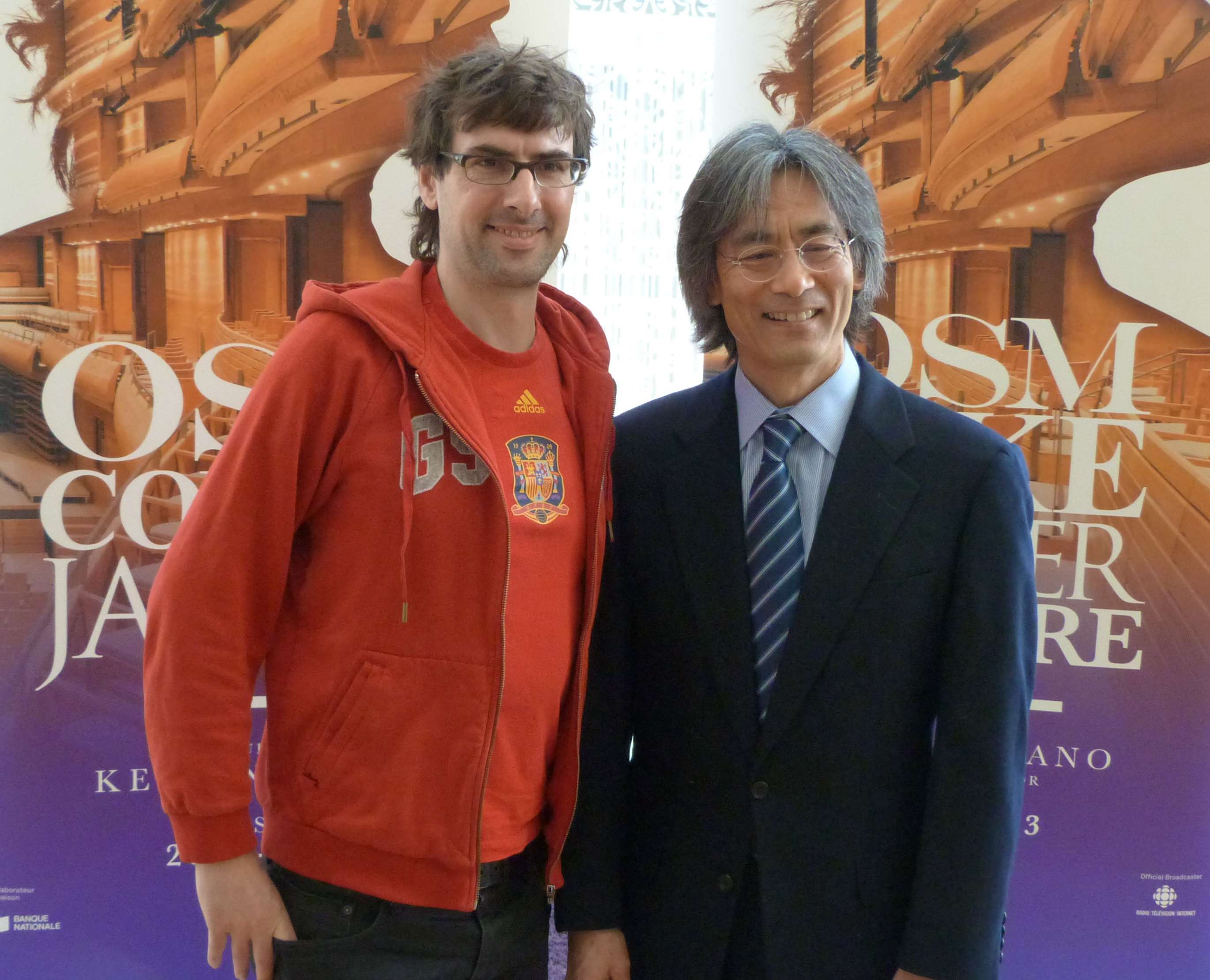|
Back
OSM Marches to a Different Beat Montreal
Maison symphonique de Montréal, Place des Arts
11/14/2012 - & November 15, 2012
Franz Joseph Haydn: Symphony no. 100 in G major “The Military”
Maxime Morin (alias DJ Champion) and Maxime McKinley: Bondye konn bay men li pa konn separe
Ludwig van Beethoven: Piano Concerto no. 5 in E-flat major, op. 73 “The Emperor”
DJ Champion (Electronic Support), Yefim Bronfman (Piano)
Orchestre symphonique de Montréal, Kent Nagano (Conductor)

D. J. Champion & K. Nagano (Courtesy OSM)
One of the ways in which Kent Nagano and the Orchestre symphonique de Montréal (OSM) have been reaching out to younger audiences has been through collaboration with pop artists, acrobats and a local DJ. The OSM took it further on Wednesday night with the world premiere of a work it commissioned from Maxime Morin (alias DJ Champion) and Maxime McKinley. Morin (b. 1969) has been a presence on the Montreal scene for 15 years and has received awards for his albums Chill’em (Saboteur Musique) in 2004 and Résistance (Saboteur Musique) in 2009. His music has been described as “intrepid in his genetic crossbreeding” (Nightlife magazine), replete with “dense sounds” and “mesmerizing musical constructions”. McKinley (b. 1979) won the Prix d’Europe for composition in 2009 and is composer in residence at Chapelle historique du Bon-Pasteur, a Montreal cultural space. Paroles & Musique noted in 2006 that “Painting, literature, philosophy, poetry and music weave an eclectic canvas in this creator’s head.”
The composers chose the Creole saying Bondye konn bay men li pa konn separe (God knows how to give, but doesn’t know how to share) to allude to the anathema purists may have towards the artists having betrayed their respective jurisdictions. But the aim is “the meeting of two worlds, and the idea of creating a complementarity between them,” McKinley explained in an interview. “The musical ‘muscles’ of DJ Champion have developed in a completely different way from mine. We have to take maximum advantage of the best of our two worlds and channel everything in the same direction.”
Nagano built the evening’s program around Haydn’s Military Symphony, as part of this season’s Haydn series. It opened the concert which concluded with Beethoven’s Emperor Concerto. As each work contains march rhythms, the new composition is based on march samplings from composers as disparate as William Byrd, Mendelssohn, Tchaikovsky, Stravinsky and Prokofiev, selected by DJ Champion, and a portion of a previously composed score from McKinley.
The 20-minute work opened with a riff by solo trumpet on Mendelssohn’s “Wedding March”. The timpani, strings and two harps joined in softly to create a floating celestial ambiance. The winds then added playful arpeggios as the orchestra moved into a gentle rocking motion, bringing to mind an ocean liner plying the high seas at night. The sound coming from the DJ’s electrostatic speakers flanking his console behind the timpani was so subtle during the first half of the composition as to be almost undetectable. But as the volume increased, some electronic emanations emerged, including a spooky whistle recalling a Halloween ghost. The principal harp and xylophone performed a beguiling duet. The “ship” then drifted off into the darkness accompanied by the tolling of a bell.
At this point, about 15 minutes into the work, a long crescending palette of sound from the orchestra, featuring a dazzling solo from principal trumpet Paul Marcelo, morphed into a heavy, 4/4 electronic “house” beat anchored by a tom tom drum. The “beat” overwhelmed the orchestra, as the latter had done to the electronic music in the first sequence. At this point the “physical” house was pounding like the heart of a breathless whale to the march from Prokofiev’s Romeo and Juliet, accompanied by electronic sputterings. A slow decrescendo permitted listeners to hear, in succession, the brass, strings and winds joining forces for a mad Turkish march, recalling the second movement from the previously played Haydn symphony. As it began, the work ended softly and was greeted by great applause, especially from the younger patrons. A little kitsch, slightly crazy but a great deal of fun.
Nagano conducted the opening Haydn with exquisite taste, delicacy and brio. The reduced orchestra included a set of “Haydn” timpani which, with the snare, cymbals and triangle, in the jaunty second movement march conjured up Turkish visions and anticipated the Mozart’s The Abduction from the Seraglio.
Beethoven’s Emperor Concerto, featuring soloist Yefim Bronfman, was equally satisfying. A frequent guest of the OSM, Bronfman played with crystal-clear articulation, assurance and a feathery touch—not subtle but also not heroic. The arpeggios flowed with liquid transparency. There was no tendency to pound or bang out the chords. Each note rang true. Bronfman is a truly distinguished pianist. The orchestral accompaniment was exemplary. Although the full complement of strings could have overpowered the pairs of horns and trumpets, their playing was almost flawless.
ConcertoNet is on Facebook
Twitter: @concertonet
Earl Arthur Love
|